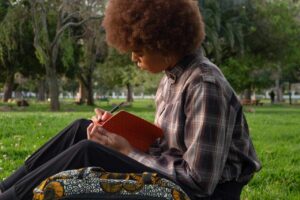As an experienced IB writer and teacher, I’ve seen first-hand the transformative power of constructive feedback and self-assessment in the International Baccalaureate (IB) framework. From my perspective, these elements are not just educational tools but essentials to shaping a student’s learning path.
Mastering the Art of Giving and Receiving Feedback
From my experience, mastering the art of feedback in the IB context is not just about academic instruction; it’s also about nurturing a supportive and collaborative learning environment.
Key Elements of Effective Feedback
In my extensive experience with the IB, I’ve understood the essence of effective feedback. It’s not just telling students what they did wrong. Feedback can guide them to improvement without discouraging their spirit. It includes:
- Clarity and Specificity. Feedback should be straightforward and pinpoint exact areas for improvement. For instance, rather than saying, “Your essay needs work,” it’s more beneficial to specify, “Your essay could be strengthened by a clearer thesis statement in the introduction.”
- Constructive Nature. Feedback should focus on how students can improve rather than just what they did wrong. For example, suggesting additional research or different approaches to problem-solving.
- Encouragement and Support. Recognize the effort and progress made. Encouragement motivates students to continue working hard.
So, the essence of effective feedback lies in its ability to be clear, specific, and kind. It’s about guiding improvement without discouraging the learner.
Common Mistakes to Avoid in Feedback
Interestingly, one common pitfall in giving feedback is an excessive focus on negatives. It’s easy to fall into the trap of only pointing out what’s wrong, but this can demotivate students. Conversely, receiving feedback requires openness and a willingness to grow. Students should see feedback as an opportunity for learning, not as criticism. Thus, it’s crucial to balance constructive criticism with positive reinforcement. Other mistakes include:
- Being Too Vague or General. Avoid general comments like “good job” or “needs improvement” without specific insights.
- Ignoring the Student’s Perspective. Feedback should be a two-way street. Encourage students to express their thoughts and challenges regarding the feedback.
- Not Following Up. Feedback is part of an ongoing process. Regular check-ins to discuss progress and further guidance are essential.
So, good feedback can significantly improve the learning process and create a culture of continuous improvement and self-reflection.
Peer Review Techniques in the IB
For peer review to succeed, students must have a sense of trust and mutual respect. Creating an atmosphere where constructive criticism is welcomed and valued is essential. Also, encourage students to discuss their thoughts openly. This can be facilitated through group discussions or one-on-one sessions where students can voice their opinions and concerns. And remember that peer review is not just about giving and receiving feedback; it’s also an exercise in critical thinking and analysis.
So, in the dynamic environment of the IB, effective peer review is a skill as crucial as any subject matter. Based on general IB criteria, a well-structured peer review process typically involves several key steps.
1. Understanding the Assignment’s Criteria
Before any review begins, students must fully grasp the assignment’s objectives and requirements. It might involve discussing the rubric or any specific expectations laid out by the instructor.
2. Preparing for Constructive Feedback
A vital part of peer review is preparing oneself to provide balanced feedback. It means being ready to identify strengths and areas for improvement and framing comments in a helpful, not hurtful way.
3. Engaging in Active Review
The review process should be interactive. Students should read or examine their peer’s work thoroughly, making notes of both positive aspects and areas where there is room for improvement.
4. Suggesting Practical Improvements
Effective peer reviewers offer actionable suggestions rather than just pointing out what’s wrong. It could involve recommending specific changes, providing examples, or directing peers to helpful resources.
5. Reflecting on Feedback
After receiving feedback, students must reflect on it. It includes understanding the feedback, asking for clarification, and considering how to apply it to their work.
Topics to Read:
- Understanding the IB Curriculum: A Beginner’s Guide
- What is IA in IB?
- Guide to the Official IBO Website for IB Student Advantages and Growth
- How to Manage Time Effectively as an IB Student
- How to Write a Strong IB IA Proposal?
- The Benefits of Pursuing the IB Diploma Programme
- What to Do if You Don’t Pass Your IB IA? How to Succeed Next Time?
- Can I Order IB Internal Assessment Written Online?
- What Are the Average IB Acceptance Rates? Insights from an IB Expert
- What Are the IB Internal Assessment Deadlines for 2024?
- What Are the Average IB Scores for US Universities?
- Does an IB Diploma Help with College Admissions?

How Self-Assessment Elevates Learning
In the context of the International Baccalaureate, self-assessment is a fundamental skill that allows students to take ownership of their learning process. This technique cultivates responsibility, critical thinking, and a deeper understanding of personal learning styles and needs. So, let’s look at methods for effective self-assessment.
1. Setting Clear Goals and Objectives
The first step in self-assessment is setting clear, achievable goals. It helps students understand their aim and provides a focus for their reflection.
2. Regularly Monitoring Progress
Students should regularly monitor their progress toward these goals. It could involve maintaining a learning journal, creating checklists, or using digital tools to track progress.
3. Asking Guided Questions
Encourage students to ask themselves questions such as, “What did I do well?” “What could I have done differently?” and “What are my next steps?” This practice helps in identifying both strengths and areas for improvement.
4. Seeking Feedback for Comparison
While self-assessment is a reflective process, comparing one’s assessment with feedback from peers or teachers can provide additional insights and perspectives.
5. Using Rubrics and Checklists
Rubrics and checklists provide a clear framework for assessment, helping students evaluate their work against defined criteria and standards.
6. Reflecting on the Learning Process
Encourage students to reflect not just on the final product of their work but also on the process they went through. It includes considering strategies used, challenges faced, and how these experiences contribute to their overall learning.
The Role of Reflection in the IB
Reflection in the IB is a tool that transforms learning from a passive to an active process. It’s about engaging in a dialogue with oneself, critically analyzing one’s work, and using these insights to improve. Here’s why reflection is integral to the IB:
- Encouraging a Deeper Understanding. Reflection helps students understand what they learned and how and why they learned it. It deepens their understanding and makes learning more meaningful.
- Fostering Independent Learning. By reflecting on their work, students develop the ability to learn independently. They become more adept at identifying their learning needs and seeking resources to meet them.
- Building a Growth Mindset. Reflection encourages a growth mindset. Students learn to view challenges as opportunities for growth rather than obstacles.
- Enhancing Metacognitive Skills. Reflection is a crucial aspect of metacognition, where students think about their thinking. This self-awareness is vital for effective learning and problem-solving.
Self-assessment and reflection are more than just academic exercises in the IB. These practices improve their academic work and lay a strong foundation for future efforts.
Applying Feedback and Self-Assessment in Real Scenarios
Drawing from my extensive experience, let me share a compelling case study that illustrates the impact of effective feedback and self-assessment. I recall a student struggling with her Theory of Knowledge (TOK) essay. The challenge was in articulating complex ideas and integrating diverse perspectives. She gained insights into various viewpoints through a structured approach to peer feedback, which greatly enriched her understanding. This process involved her peers providing constructive criticism of her argument structure and suggesting alternative ways to present her ideas.
Moreover, self-assessment played a critical role in her improvement. She regularly reflected on her writing, asking herself critical questions about the clarity of her arguments and the strength of her evidence. By actively seeking out and acting on feedback and rigorously assessing her work, she developed a stronger, more nuanced understanding of TOK concepts. The result was a remarkable improvement in her essay grades, reflecting a more profound comprehension and better communication skills.
Don’t let the stress of the IB curriculum hold you back.
Are you struggling to come up with topic suggestions for your IB Internal Assessment? Or do you need help with External Assessment?
Our experienced writers can help you choose the perfect topic and assist you with any assignment.
Tailored to your specific subject and requirements.
Our experienced IB writers are always ready to help.
Simply click:

Tools and Resources for IB Students
The IB path is challenging, but fortunately, numerous tools and resources can help students in this process. Some of the most beneficial include:
- Online Forums and Communities. Platforms like IB Survival and Reddit’s IB community offer spaces where students can share resources, seek advice, and discuss various aspects of the IB program.
- IB-Specific Writing Guides. These guides provide valuable insights into structuring essays, conducting research, and writing effectively for different IB subjects. They are handy for tasks like the Extended Essay and TOK.
- Feedback Software. Tools like Turnitin provide valuable feedback on writing, helping students identify areas of plagiarism, improve their writing style, and ensure academic integrity.
- Digital Learning Platforms. Websites like Khan Academy and Coursera offer courses and materials that can supplement IB learning, particularly in challenging areas like mathematics, sciences, and languages.
- Self-Assessment Tools. Various apps and software enable students to track their progress, set goals and self-assess their learning. These tools often include features for reflection, goal-setting, and monitoring academic growth.
- Peer Review Groups. Joining or forming peer review groups can be incredibly beneficial. These groups provide a supportive environment where students can give and receive feedback, share resources, and collaborate on learning.
By actively engaging in feedback and self-assessment and using available resources, IB students can significantly improve their academic performance.
The Bottom Line
In conclusion, engaging in constructive feedback and self-assessment is not just about academic growth but personal development. These techniques are instrumental in shaping well-rounded, reflective learners. As you continue on your IB path, remember that the power to improve your learning lies as much in the feedback and self-assessment processes as in the knowledge you acquire.
And remember that you can always turn to someone if you need help with the IB curriculum. Our IB Writing Service team is always here for you!




